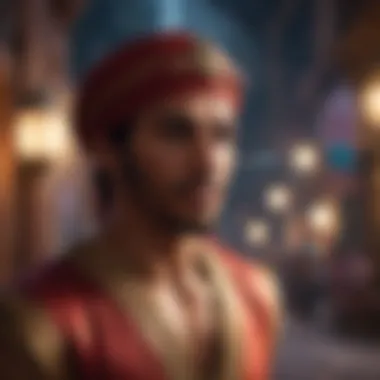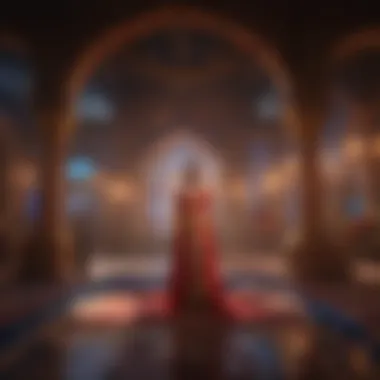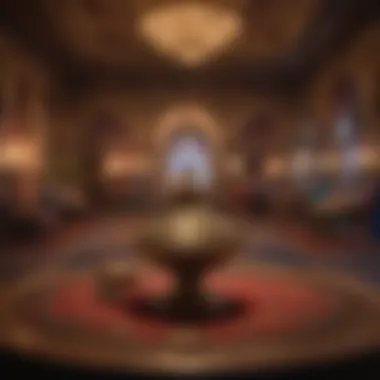Cultural Significance of Aladdin on Disney Plus


Intro
The film Aladdin, as showcased on Disney Plus, represents more than a mere adaptation of a classic tale. It serves as a fascinating case study for cultural significance in modern entertainment and film accessibility. This narrative thread connects past cultural representations with contemporary re-imaginings. It prompts various questions about how the perception of stories evolves in different eras. The unique features of this live-action adaptation, alongside its cultural context, reveal much about how narratives are consumed and interpreted today.
Streaming services, particularly Disney Plus, have reshaped how audiences engage with film. This shift illuminates significant access to previously less available stories.
In this article, we will explore the features of Aladdin, comparing it with its animated predecessor, analyzing its reception, and examining the broader cultural implications. By contextualizing Aladdin within the current landscape of entertainment, we aim to understand better how such adaptations impact viewers in a rapidly changing media environment.
Preface to Aladdin on Disney Plus
The introduction of Aladdin on Disney Plus marks a significant milestone in the realm of digital entertainment. Disney's strategy to offer their extensive catalog through streaming fulfills a growing demand for accessible and diverse content. Aladdin, in its various forms, represents a pivotal piece of this catalog, embodying themes and elements that resonate with both classic and contemporary audiences.
Overview of the Film
Aladdin, originally released in 1992, is an animated film that has become synonymous with Disney's legacy of enchanting storytelling. It presents a narrative centered around a young man from humble beginnings who discovers a magical lamp and, ultimately, himself. The film is not just a tale of adventure; it explores deeper themes such as identity, love, and the quest for freedom. The transition to Disney Plus allows a new generation to experience these messages within a platform where they can seamlessly engage with a wealth of similar stories.
Importance of Streaming Platforms
Streaming platforms like Disney Plus have transformed how audiences consume films. They have disrupted traditional viewing habits, allowing users to watch content on demand, thus altering the relationship between the viewer and the film. Disney Plus specifically emphasizes its role in promoting the cultural significance of films like Aladdin. By making classic films available alongside new releases, it highlights the continuity and evolution of storytelling. Moreover, these platforms increase accessibility. Viewers from different cultural backgrounds can engage with stories that may have otherwise been missed in theatrical releases. Aladdin, with its rich cultural backdrop, gains fresh relevance as it reaches a diverse audience, facilitating conversations about representation and understanding across various demographics.
The availability of Aladdin on Disney Plus allows for an exploration of its cultural and entertainment significance through rewatches, discussions, and a more personal engagement.
In summary, Aladdin on Disney Plus serves not only as a nostalgic journey for longtime fans but also as an introduction for new audiences to engage with its themes. The streaming platform's impact on viewing habits and cultural narratives cannot be overstated, solidifying Aladdin's standing as a significant cultural artifact in the contemporary entertainment landscape.
Historical Context of Aladdin
Understanding the historical context of Aladdin is essential for grasping the film's significance within both cinema and culture. This section will explore the origins of the story, the impact of Disney's animated classic, and the transition to the live-action adaptation. Each element reveals how Aladdin has evolved and its role in shaping cultural narratives around storytelling.
Origins of the Aladdin Story
The story of Aladdin originates from the collection of tales known as One Thousand and One Nights, or Arabian Nights. This particular tale appears to be integrated into the collection much later than the original tales, likely stemming from various oral traditions across the Middle East and South Asia. By analyzing the early themes of desire, adventure, and moral lessons, we can understand how the narrative has captivated audiences over centuries. The narrative serves as a mirror to the society and culture of its time, illustrating the values and struggles prevalent in those historical contexts.
Disney's Animated Classic
Disney's 1992 animated version of Aladdin marked a significant cultural moment in animation. It introduced a vibrant aesthetic and unforgettable musical numbers, reshaping how animated films were perceived. The voice performances, especially Robin Williams as the Genie, brought a new level of charisma to animated characters. This film also played an important role in shaping Western perceptions of Middle Eastern culture, albeit with a blend of fantasy and exaggeration. Critics argue that while it provided entertainment, it also contributed to stereotypes that can mislead audiences about the real-world cultures it depicts.
Transition to Live Action
The live-action adaptation of Aladdin, released in 2019, generated both excitement and skepticism. This version aimed to bring a fresh perspective to the classic story while addressing some of the criticisms aimed at the animated film. By incorporating more diverse casting and broader narratives, it attempted to enhance cultural representation and relevance. However, the adaptation encountered challenges in balancing nostalgia with new storytelling techniques. Observing the different approaches allows us to appreciate the film's ongoing evolution and its persistent relevance in contemporary society.
"The importance of understanding the historical context lies in its ability to provide a nuanced lens through which we can examine the film's contribution to our cultural landscape."
In this context, Aladdin serves as a pivotal example of how animation, storytelling, and cultural representation interact within the larger framework of entertainment. The historical context not only enriches our understanding of the film but also invites critical contemplation about its implications in today's media environment.
Character Analysis
In examining Aladdin on Disney Plus, character analysis is critical. Characters shape the narrative and embody the film's themes. By evaluating each main character, we gain clearer insights into their individual journeys. Their development reflects societal norms and shifts in cultural paradigms. This exploration reveals how characters resonate with audiences today, demonstrating their lasting significance in modern storytelling.


Aladdin's Development
Aladdin evolves from a street rat to a prince, portraying an essential storyline about self-discovery. Initially, he demonstrates quick thinking and resourcefulness, traits that help him navigate difficult situations. Through his relationship with Jasmine, he learns that authenticity holds value beyond wealth. This growth underscores a central theme: true worth lies in one's character rather than social status.
Aladdin’s journey is layered with elements of personal conflict. He grapples with his identity throughout the film. The internal struggle he faces resonates with many viewers who have experienced similar quests for self-acceptance. His arc, enriched by interactions with the Genie and Jasmine, illustrates the importance of relationships in personal growth.
Jasmine: A Modern Representation
Jasmine's character is significant as she represents female empowerment. In the animated version, she is often seen as a prize to be won. However, the live-action adaptation presents her as assertive and independent. She actively seeks to affect change within her kingdom.
Her willingness to defy norms and voice her opinions sets a new precedent for female characters in animated narratives. This modern portrayal aligns well with contemporary discussions surrounding gender roles. It encourages women to challenge societal expectations while remaining true to their desires.
Perceptions of Jasmine’s character also reflect broader cultural discussions. Her ethnic background and style have sparked conversations around representation in media. Displaying diversity in character development fosters a deeper understanding of different cultures, which is crucial in today's globalized world.
The Genie: From Animation to Reality
Robin Williams' role as the Genie in the animated film is iconic and almost irreplaceable. Yet, Will Smith's portrayal in the live-action adaptation offers a fresh and distinct interpretation. This shift invites discussions on how essential characters can adapt to different contexts.
The Genie embodies freedom and spontaneity, serving as a counterbalance to Aladdin's more reserved nature. His humorous approach to life contrasts with Aladdin's challenges. This dynamic illustrates how individuals from different backgrounds can complement each other on their journeys.
Smith's interpretation also brings a modern touch to the Genie's character. He integrates contemporary cultural references, linking various generations of audiences. By blending humor with sincere wisdom, the Genie’s portrayal in both versions reveals layers of emotional depth that cater to a wider viewer demographic.
Ultimately, each character in Aladdin plays a pivotal role in its storytelling. Their development and representation speak to the cultural shifts within our society, reflecting stories that continue to evolve in relevance.
Cultural Significance
The cultural significance of Aladdin on Disney Plus is multifaceted. It extends beyond mere entertainment, serving as a vehicle for reflection on identity, representation, and the perceptions held about various cultures. The film plays a critical role in shaping how audiences engage with and understand Middle Eastern culture. Given the rise of streaming platforms like Disney Plus, the accessibility of films like Aladdin influences contemporary cultural narratives.
Representation in Cinema
Representation in cinema, particularly regarding the Aladdin franchise, is a pivotal aspect of its cultural significance. It exposes the audience to the complexities and richness of Middle Eastern stories. However, the portrayal has often raised concerns about accurate representation. The animated version featured a range of distinctive characters and relied on a mix of cultural elements that some scholars view as a superficial understanding of the culture.
- The live-action film sought to address these issues by integrating a more diverse cast, aiming to depict characters in a more authentic manner.
- This represented an effort to correct past missteps and reflect broader societal movements towards inclusivity.
Aladdin’s journey from an animated classic to a live-action retelling is significant for ongoing discussions about representation. Disney's efforts to incorporate authenticity can influence the industry standards, encouraging filmmakers to approach cultural stories with sensitivity and a commitment to fidelity.
Perceptions of the Middle East
How Aladdin informs perceptions of the Middle East is a critical point of analysis. The film traverses both cultural fantasy and the representation of a land that might be unfamiliar to many audiences. The vibrant visuals and idealistic portrayal might lead to skewed perceptions.
- The animated film, despite its charm, contributed to stereotypes. This phenomenon has often resulted from generic portrayals that failed to reflect real experiences and cultures.
- The recent live-action adaptation has made substantial attempts to reframe these narratives, addressing misconceptions.
"Walt Disney had a vision that extended beyond animation; it was about creating a sense of wonder that both reflects and distorts reality."
Visual and Musical Elements
The visual and musical components of Aladdin play a crucial role in creating an immersive experience that resonates with audiences. Both aspects not only elevate the storytelling but also enhance the cultural richness of the film. Understanding these elements helps to appreciate how they contribute to the broader impact of the movie on Disney Plus.
Cinematography in Aladdin


Cinematography in Aladdin is integral to its storytelling approach. The dynamic camera movements and vibrant color palettes blend seamlessly to establish the film's magical setting. This is especially evident during scenes that depict Agrabah's bustling marketplace or the grand palace sequences.
The use of wide-angle shots captures the grandeur of the environments, while close-ups focus on the characters' emotions. Each frame is meticulously crafted to evoke a sense of wonder, a key characteristic of Disney's animated films. Furthermore, the decision to incorporate both CGI and practical effects in the live-action adaptation showcases a commitment to detail that appeals to modern audiences.
"Cinematography is not just about how a shot looks; it's about how it makes the audience feel."
The fluid transitions between scenes, facilitated by the strategic placement of the camera, provide a rhythm that keeps viewers engaged. This attention to cinematography not only enhances the visual experience but also underlines the film's themes of adventure and discovery.
Musical Score and Composition
The musical score and composition are vital assets that define Aladdin's identity. Composed by Alan Menken, the film's original soundtrack features a blend of captivating melodies and culturally inspired rhythms. Each song is tailored to reflect the emotions and motivations of its characters.
For example, "A Whole New World" is a cornerstone moment in the film, representing Aladdin and Jasmine's aspirations and dreams. The arrangement evokes a sense of longing and adventure, reinforcing the overarching themes of freedom and exploration.
The musical elements, combined with the visual storytelling, contribute to the film's emotional weight. It allows audiences to connect with the characters and their journeys on a deeper level. Moreover, the reception of the film's soundtrack has led to its recognition within pop culture, contributing to the longevity of Aladdin as a beloved narrative.
In a streaming age, soundtracks have become more than just background music; they are integral to audience experience. Disney Plus makes this content readily available, allowing fans to engage with both the visuals and the soundscapes of their favorite scenes. Aladdin exemplifies how a well-composed score can elevate cinematic storytelling and resonate with viewers globally.
Critical Reception
The critical reception of Aladdin, particularly in its live-action iteration, plays a crucial role in shaping public perception and understanding of the film’s broader significance. Critics assess several facets of the film, including performance, direction, accuracy to source material, and cultural representation. These evaluations have implications not only for audience enjoyment but also for future adaptations of culturally rich stories. The discourse surrounding Aladdin on Disney Plus demonstrates how viewing platforms can influence reception and discussion, particularly regarding representation and storytelling.
Initial Impressions of Live Action
Upon its release, the live-action Aladdin generated varied reactions among critics and audiences alike. Many praised the visual aesthetics and the nostalgia it invoked, while others raised concerns regarding cultural authenticity. Comparing it to the animated classic, some felt that the live-action version struggled to capture the spirit of the original.
- Positive Aspects:
- Critiques:
- The performances, especially by Will Smith as the Genie, were often highlighted. His portrayal brought a new energy to a beloved character.
- The film's vibrant visuals and elaborate set designs attracted commendation for their aesthetic appeal.
- Critics pointed out that while the film aimed to modernize its characters, it fell short in accurately representing Middle Eastern culture.
- Some elements were considered overly formulaic, leading to a lack of depth in storytelling compared to the animated version.
These initial impressions help frame the film within its cultural context, guiding audiences on what to expect and prompting further conversation about representation in media.
Audience Reception on Disney Plus
The audience reception of Aladdin on Disney Plus reflects a more diverse set of opinions compared to its theatrical run. This platform allows viewers to revisit the film within a familiar context, encouraging both nostalgia and fresh interpretations.
Many viewers embraced the opportunity to watch it in the comfort of their homes, often discussing it in online forums. Platforms like Reddit and Facebook become lively spaces for discourse, where users express their thoughts on the film’s themes and representation.
- General Sentiments:
- Critical Discussions:
- Viewers appreciated the film for its music and visual spectacle, reminiscent of the original animated film.
- New audiences, particularly younger viewers, found it entertaining, which is critical for the film’s longevity.
- Online discussions have revealed ongoing concerns over cultural representation.
- Some audiences compared live-action elements unfavorably against the animated classic, highlighting what they viewed as missed opportunities.
In light of the cultural significance of the film, audience reception on streaming platforms like Disney Plus reveals its evolving place in contemporary entertainment, prompting a deeper examination of how stories are told through different mediums.
Comparative Analysis


A comparative analysis of Aladdin serves as a critical lens through which we can examine the shifts in storytelling, character development, and thematic depth between the live-action and animated versions of Disney's beloved tale. This section elucidates the distinct advantages and potential drawbacks of each format, shedding light on how their respective presentations influence cultural perception and audience connection.
Live Action vs. Animated Versions
The transition from animated to live action in the Aladdin franchise has sparked considerable discussion among audiences and critics alike. The animated version, released in 1992, remains a cornerstone not only for Disney but also for the animation industry at large. Its vibrant colors, imaginative landscapes, and expressive character designs set a high standard. In contrast, the 2019 live-action remake offers a reinterpretation that strives for more realism—a shift that could enhance engagement but risks losing the original's charm.
The animated film focuses heavily on visual storytelling through animation techniques that evoke certain emotions. Characters like the Genie are brought to life in vibrant colors, captivating movements, and exaggerated features that convey personality traits. Meanwhile, the live-action adaptation utilizes actors, technology, and real-world settings to ground the narrative. This presents a new level of relatability but may also inadvertently strip away some whimsy that animation naturally provides.
Another aspect to consider is the soundtrack. The animated version’s score by Alan Menken and lyrics by Howard Ashman creates an unforgettable experience with catchy, light-hearted tunes. The live-action counterpart also revisits these beloved songs while introducing new pieces. However, the overall timbre and delivery differ significantly between the two, which may affect how audiences resonate with the music.
Consequently, this contrast engenders differing audience expectations and receptions. Hardcore fans of the original might approach the live-action Aladdin with skepticism. They could perceive the reinterpretation as a dilution of their cherished childhood memories, while new audiences might appreciate the inherent cultural updates and fresh performances.
Different Interpretations of Core Themes
A deeper exploration of the core themes reveals yet another layer of complexity in the comparative analysis of Aladdin. At its heart, the story grapples with ideas of identity, freedom, and aspiration. The animated version presents these themes with a clear, vibrant clarity. Aladdin's journey from street rat to prince emphasizes the importance of staying true to oneself irrespective of societal status.
Conversely, the live-action adaptation receives critique for attempting to delve deeper into character backstories and motivations. For instance, it places greater emphasis on Jasmine’s pursuit of agency within a traditional context, thus redefining her role in the storyline. This provides a modern interpretation that resonates strongly with contemporary audiences, emphasizing female empowerment in a more pronounced manner than in its predecessor.
Nevertheless, this new focus could muddy the waters. Some may argue that too much emphasis on character development detracts from the primary narrative arc, leading to a less cohesive experience. This debate highlights a significant cultural shift in the expectations of viewers today, who increasingly favor nuanced portrayals over simpler narratives.
In summary, the comparative analysis of Aladdin reveals critical insights into the evolution of storytelling through animation and live action. By examining the nuances in character, music, and thematic interpretations, we can better understand the ongoing cultural discourse surrounding Disney's adaptations and their resonance with diverse audiences. Aladdin is not just a story about magic and adventure; it encompasses broader societal dialogues that reflect the times.
Impact of Streaming on Viewing Habits
The emergence of streaming platforms has revolutionized how audiences consume films and television. This shift is particularly relevant when analyzing the impact of Aladdin on Disney Plus. The film serves as a case study for understanding broader changes in viewing habits driven by accessibility, personalization, and the demand for on-demand content.
Changing Consumption Patterns
With the rise of streaming services, audiences increasingly favor binge-watching and the ability to access content anytime and anywhere. Aladdin, available on Disney Plus, epitomizes this trend. Viewers can now watch the film repeatedly without the constraints that come with traditional release formats. This convenience alters the way they engage with the story, enabling deeper exploration into its cultural nuances and character development.
Major changes in consumption patterns include:
- Convenience and Flexibility: Audiences can choose when and where to view Aladdin, allowing for tailored viewing experiences that traditional cinema cannot replicate.
- Binge-Watching Culture: Users often consume content in bulk, creating conversations and reflections around the film that extend beyond a single viewing.
- Engagement through Community: Online discussions on platforms like Reddit or Facebook foster community among fans who analyze and share their insights about the film, making the viewing experience more communal.
Implications for Future Releases
The success of films like Aladdin on streaming platforms signals a possible shift in how studios approach future projects. Here are several implications:
- Increased Focus on Diversity: The popularity of Aladdin highlights the importance of representation in films. Future releases may increasingly prioritize diverse storytelling to engage broader audiences.
- Experimentation with Formats: Studios might explore new narrative structures or series adaptations of classic films, as the streaming platform allows for experimentation with longer story arcs.
- Targeted Marketing Strategies: Streaming services gather valuable data on viewership patterns, enabling more effective marketing strategies for upcoming films tailored to audience preferences.
"Streaming is not just a trend; it is the mechanism through which audiences define their viewing experience today."
Overall, the impact of streaming on Aladdin illustrates a complex interplay between audience desires and industry adaptions. As habits evolve, the film's enduring popularity reaffirms its significance in the digital landscape, charting a course for future innovations in content delivery.
Culmination
The exploration of Aladdin's cultural and entertainment significance on Disney Plus reflects not just on the film itself but also on the changing landscape of media consumption. In this article, we have delved into various aspects, from the historical context of the story to its critical reception and the impact of streaming. Understanding the legacy of Aladdin is essential as it connects contemporary audiences with cultural narratives that have been part of global storytelling for centuries.
Revisiting Aladdin's Legacy
Aladdin has left a profound mark on both pop culture and Disney's legacy. The original animated film set a benchmark for representation in animation, showcasing characters from diverse backgrounds. The live-action adaptation revived this legacy for a new generation, featuring a blend of nostalgia and modern storytelling. The character development seen in both versions highlights the continual evolution of societal values. Aladdin's journey not only entertains but also sparks discussions on themes such as identity, ambition, and respect for cultural differences.
The Role of Disney Plus in Content Distribution
Disney Plus has transformed how audiences access and engage with films like Aladdin. The platform allows for immediate availability of classic and new content, enabling viewers to revisit these narratives at their own convenience. Moreover, the addition of bonus content, such as behind-the-scenes footage and interviews, enriches the viewing experience. As Disney explores innovative distribution methods, it is impacting not just its catalogue but also shaping future content strategies across the industry. The platform’s role in promoting accessibility and expanding audiences cannot be understated.



